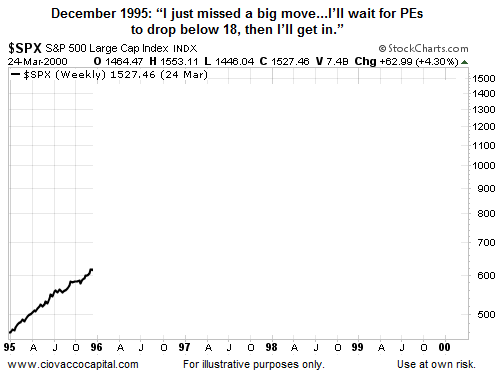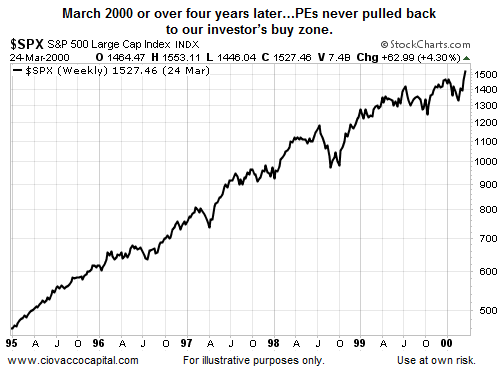Myth Busters Part III
We recently examined the performance of “safe” blue-chip dividend stocks and “stable” utilities during the 2007-2009 bear market; the results may have been surprising to some. Since price-to-earnings ratios (PEs) are often used to identify favorable entry points or “overvalued” levels for stocks/indexes, the next logical question is:
Are PE ratios a good investment timing tool?
We All Want To Protect And Grow Capital
If we get down to brass tacks, the basic objective of all investors centers around this basic premise; we all want to make money and we all do not want to lose money. According to multpl.com, the S&P 500’s PE ratio was 19.69 on July 1, 2014, based on the latest reported earnings and recent market price. Having worked on Wall Street for 20 years, a PE ratio of 19.69 sounds rich, but does that mean stocks are overpriced and it is time to get out?
Missing Four Of The Greatest Years In Stock Market History
To answer that question, we will turn to historical facts. For our hypothetical historical example, we will assume the following:
- It is December 1, 1995, our investor is 55 years old and has been sitting on $500,000 cash waiting for the market to pull back to reach a more favorable buy zone.
- Our investor, who just missed a big rally in the first eleven months of 1995, finally says “I have to get invested”.
- The S&P 500’s PE ratio on December 1, 1995 was 18.10. Our investor decides that he will pull the investment trigger as soon as the PE ratio dips below 18. Note: The same rationale could be used in 2014.

- Unfortunately, waiting for stocks to reach his buy zone became an even more frustrating exercise. As shown in the table below, the S&P 500’s monthly PE never dropped below 18 between December 1, 1995 and April 1, 2000.

Stocks Can Remain Overvalued For Years
If we asked our hypothetical investor in late 1995:
What are the odds the S&P 500’s PE ratio does not dip back below 18 over the next 52 months?
Since most valuation-oriented investors believe every overvalued market is overdue for a pullback, our guess is our 1995 investor would have responded with:
The odds are almost zero that PEs will not dip back below 18 in the next 52 months.
Lost Opportunity Using PEs As Timing Tool
Investing risks include opportunity costs. We all will experience a limited number of bull markets and investment bubbles in our lifetime. How much money did our value conscious investor leave on the table? If we assume for illustrative purposes that we invested in the S&P 500 ETF (ARCA:SPY) on 12/1/1995 we would have paid $43.80 per share (on an adjusted basis). SPY was worth $117.98 in the spring of 2000 when the aggregate market opinion, which is what sets asset prices, finally decided “stocks are too expensive”. It is the market’s perception of valuations that matters, not that of an expert or individual investor. In dollar terms, a $500,000 investment in the S&P 500 ETF would have grown to $1,346,804, meaning the hypothetical opportunity cost of not participating was $846,803.


Are Valuations Meaningless?
Absolutely, positively no. Valuations, in the long-run, are very meaningful. Common sense tells us that all things being equal, we are better off buying when PEs are lower rather than higher.
Valuations Are Poor Investment Timing Tools
The point of this exercise is to show that during a bull market, PEs are poor timing tools to help with entries and exits. It is impossible to look at the $846,803 opportunity cost between late 1995 and Q1 2000 and come to any other rational conclusion. The whole purpose of a timing tool is to “stay in” when money can be made and “get out” in the early stages of a “money is being lost” period. Any timing tool that keeps you out of one of the greatest bull runs in stock market history is a poor timing tool. Any timing tool that is wrong for over four years is a poor timing tool. Any timing tool that helps you miss an opportunity to more than double your money is a poor timing tool.
Well, 1995-2000 Was An Exception, Right?
No, investment bubbles that feature high valuations that can last for years are more common than many believe. The list below shows numerous irrational investment bubbles have occurred in history.
- Tulip mania (1634-1638)
- The Mississippi Bubble (1719-1720)
- The South Sea Bubble (1720)
- Roaring Twenties Bull Market (1924-1929)
- Japanese Bubble (1984-1989)
- Dot-Com Bubble (1996-2000)
- Housing & Mortgage Bubble (2005-2007)
But, All Those Bubble Were Followed By Busts
Yes, and the whole purpose of a “timing tool” is to allow you to capture a good portion of the bubble gains and help you avoid a good portion of the “give back” after the bubble pops. Remember, we did not say PEs were useless, we just said they do not make good investment timing tools. The best way to sum up this analysis is as follows:
How would you feel if you were told in 1995 that PEs are good investment timing tools, and then subsequently missed an opportunity to more than double your money in just over four years? It is not out of the realm of possibility that a value-conscious investor could look back four years from now and feel the same way. That is not a prediction, but rather a statement regarding possibilities and probabilities.
Is There Anything That Can Help?
While there is no single indicator, moving average, or ratio that can serve as the holy grail of investment timing, there are numerous ways to improve our odds of staying invested when the odds are favorable and reducing investment risk when the market’s risk-reward profile starts to deteriorate. Before reviewing the examples below, it is important to emphasize, they are used to illustrate concepts, not serve as a complete market timing system:
- 1987 – Did It Come Out Of Nowhere?
- 2008 – Was There Anything Investors Could Have Done
- 2010 – Did Any Warnings Come Before The Flash Crash?
2014: What Does The Evidence Say Now?
This week’s stock market video covers risk management concepts in the context of the 2014 market. More specifically, it answers the question how concerned should we be about recent weakness in the stock market?
Are moving averages the magic bullet of investing? No, but they can be helpful when used in a disciplined, rules-based system. Since moving averages are not a perfect timing tool, it is prudent to add additional inputs into your system to provide indicator redundancy or time frame diversification. For example, this table provides an example of using multiple inputs on multiple timeframes. The concepts are explained in more detail in:
- You Need A Plan For The Next Inevitable Bear Market
- Stocks Bubbles: Can Investors Profit While Monitoring Risk?
The Market Determines What Is A Fair Price To Pay
If we polled value-conscious investors in 1995, 1996, 1997, and 1998, it is fair to say they would have returned comments that included “overvalued”, “way overvalued”, and “overdue for a correction”, and “this can’t last”. Were those comments eventually proven to be correct and insightful? Yes, those comments looked smart after the bubble popped in the 2000. However, those comments, based on personal opinions of fair valuation, did not serve as good timing tools, nor did they help investors stay with a strong bull market/money-making opportunity. Investing is about making and protecting capital, rather than feeling good or looking smart. For the record, the stock market did not agree with the term “overvalued” in 1995. The market determines the value of our portfolios, rather than personal opinions, which is an extremely important concept that was outlined in detail in You Will Never Look At The Markets The Same Way Again.
Approach Has To Make Sense To You
The beauty of the markets is there are countless ways to skin the risk management cat. Our approach is one of many. Investors should find a risk management system that allows them to say “that makes sense to me”. Valuations are unquestionably an important part of investing, but that does not mean they serve as a good “when to buy” and “when to sell” tool during an established bull market. We are in an established bull market now, which means PEs, based on the hard evidence above, are not particularly useful for timing investment decisions.
Investing Is Difficult – Fed Has Been Easy
Our purpose here is to show that during bull markets, and especially bubbles, valuations can become stretched beyond our wildest dreams. With the Fed pumping freshly printed money into the financial system (QE) over the past few years, it is not hard to visualize a few more years of bubble-like returns. If our system can address the two most important questions, then we can improve our odds of success in bubble-like bull runs and wealth-destroying bear markets. Risk management is all about odds. Odds speak to uncertainties. We live in an uncertain world. There are ways to reduce, not eliminate, investment uncertainty and risks.
Current Market
As noted in the 2014 video above, the present day market is still holding up relatively well. We will enter next week with a flexible and open mind. For now, a mix of stocks (SPY), and leading sectors (NASDAQ:QQQ) remains prudent.
